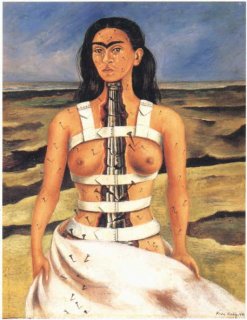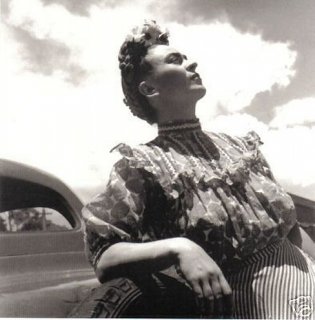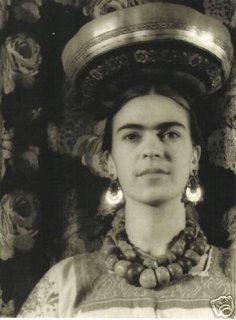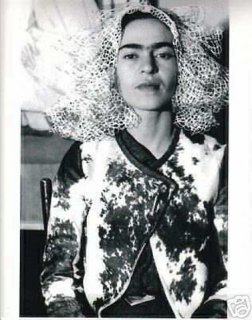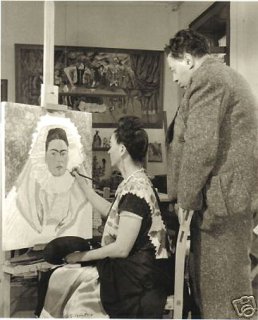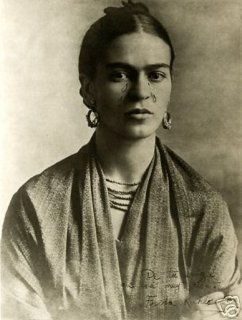You are using an out of date browser. It may not display this or other websites correctly.
You should upgrade or use an alternative browser.
You should upgrade or use an alternative browser.
Frida Kahlo
- Thread starter Estella*
- Start date
travis_nw8
mmmmmm...fashion....
- Joined
- Mar 23, 2005
- Messages
- 2,507
- Reaction score
- 1
well frida kahlo is back in fashion for the summer. tate modern has a major exhibition which is well worth seeing ( just dont't go on a sun afternoon like me- ah art rage!), and even selfridges has a couple of her frocks exhibited in the corner window. i think it's important to note that she dressed for diego - who preferred women to look like women- so she adopted the dress of the peasent class from a very traditional rural mexican province to please him ( dispite frida coming from a affluent cosmopoliton family)
somnambule
Member
- Joined
- Jan 31, 2005
- Messages
- 575
- Reaction score
- 1
odelay said:awesome idea for a thread! so much more interesting thtan parishilaryolsentwin bs.
oh yes,i agree
 !!!i´m really not an expert regarding frida kahlo,but i appreciate this thread a lot and it makes me want to get to know her better!!
!!!i´m really not an expert regarding frida kahlo,but i appreciate this thread a lot and it makes me want to get to know her better!!MulletProof
Well-Known Member
- Joined
- Apr 18, 2004
- Messages
- 28,900
- Reaction score
- 7,979
that line made me laughtravis_nw8 said:well frida kahlo is back in fashion for the summer.

MulletProof said:that line made me laugh
 , i know what you think.
, i know what you think.the exhibition at tate modern http://www.tate.org.uk/modern/exhibitions/kahlo/
and an article about ^
from www.24hoursmuseum.org
BLOCKBUSTER! FRIDA KAHLO AT TATE MODERN By Helen Barrett 08/06/2005
Helen Barrett went to Tate Modern's new Frida Kahlo show, on display until October 9 2005, to see what the fuss is about.
Frida Kahlo's art was described by the Surrealists' champion Andre Breton as "a ribbon about a bomb". Her 87 paintings and drawings assembled for this summer's Tate Modern blockbuster exhibition showcase the Kahlo phenomenon: her physical suffering, preoccupation with death, mental trauma and political conviction – all wrapped up in a riot of colour and costume.
This combination of intrigue and style has earned Kahlo adulation and cult status in recent years. Hollywood turned her life story into a film, Madonna collects her paintings, and artists such as Tracey Emin and Cindy Sherman are inspired by her uncompromising themes. For Tate Modern, Kahlo is a guaranteed crowd-pleaser.
At times, Kahlo's cult status threatens to overshadow her painting. Tate curators Emma Dexter and Tanya Barson have focused on the testimony of her work.
As Dexter explains: "Paintings have been grouped into rooms that follow the chronology of her life, interspersed with themes such as still lifes and self portraits." It's a device that allows the paintings to unfold the drama of Kahlo's short, traumatic and adventure-packed life.
Born into the Mexican urban middle-class in 1907, Kahlo began painting at 20 following a horrific bus crash that shattered her spine and fractured her legs, pelvis, collarbone and ribs. She painted, she said, because she was "bored as hell in bed". An almost incidental pencil sketch, The Accident, recalls the horror of the incident: the bus, the moment of impact, the bodies lying in the street.
Rarely seen early work on display sees her dabbling in contemporaneous avant-garde styles such as Cubism and Futurism as well as Renaissance-style portraits. The elongated necks and bodies, lavish clothing and mannered gestures of Self-Portrait Wearing a Velvet Dress of 1926, and Portrait of Alicia Galant of 1927 recall Raphael and Botticelli.
In 1929 at 21, Kahlo married Mexico's celebrated socialist muralist, Diego Rivera. He was 20 years her senior, and a leading light in Mexico's post-revolutionary intellectual elite. Inspired by Rivera's public space murals, Kahlo began to incorporate deliberately naive, vernacular folk art into her paintings, achieving, says Barson, a "mature voice".
"Kahlo intended her work to develop a sense of national pride in the most humble creations of its peasants," adds Dexter. "What might look like very innocent still-life subjects are part of the Mexicanidad movement.”
Mexicanidad meant imbuing mundane objects with cultural and political significance. In Self Portrait on the Borderline Between Mexico and the United States, she appears on a pedestal between two worlds: the industrialised ‘tainted’ US, represented by towering car factories, and a fecund Mexican landscape strewn with ancient temples and artefacts.
Elsewhere, paintings such as Madonna's contribution to the exhibition, My Birth, and the disturbing Henry Ford Hospital examine Kahlo's experience of miscarriage with disarming honesty.
In the latter, disparate paraphernalia litters the scene, including a snail, to represent the slowness of the process, and an orchid, which Kahlo likens to medical illustrations of the uterus.
Kahlo develops this graphic, confessional approach with her iconic 1939 masterpiece, The Two Fridas, her best-known work.
This double self-portrait – painted following her divorce from Rivera - features Frida in traditional Mexican costume with her heart exposed, representing the woman that Diego loved, next to the unloved Frida, holding her severed heart and wearing a wedding dress splattered with blood.
Kahlo's story at Tate Modern culminates in her later work, inspired by an admiration for mysticism, and starring the ambitious and extraordinarily detailed 1945 canvass, Moses.
In what Dexter describes as "a positive image of uplifting spiritual humanity" Kahlo attempts a jumbled narrative of religion and spirituality, featuring kitsch mini-portraits of unlikely figures such as Gandhi, Stalin, Napoleon and Hitler surrounding the infant Moses floating in a basket of rushes.
Frida Kahlo is the first major UK exhibition of her work in over 20 years, and reveals not only her revered exotic self-portraits but also the less well-known aspects of her work: her insights into questions of national identity, the plight of the indigenous peasant poor and Mexico's turbulent relationship with its neighbour, the United States.
The exhibition achieves a detailed narrative of Kahlo’s life beyond the myth; an uncompromising woman whose art was charged with incendiary political and personal conviction – Breton’s unexploded ‘bomb’.
DosViolines
far from home...
- Joined
- Aug 21, 2005
- Messages
- 3,212
- Reaction score
- 12
DosViolines
far from home...
- Joined
- Aug 21, 2005
- Messages
- 3,212
- Reaction score
- 12
source: american-buddha.com












- Joined
- Jan 21, 2004
- Messages
- 4,896
- Reaction score
- 3
karma anna_karina for the thread, i had never seen it before... most of us mexicans are very proud of this woman, so talented and intelligent... a true individual, a great mexican icon
fab_fifties_fille
crossed wires.
- Joined
- Nov 18, 2004
- Messages
- 5,421
- Reaction score
- 1
We were discussing Frida and inparticular her 'broken column' painting in my last art history lecture...a very interesting life full of affairs, (both hers and her husbands) a crash, disability, heartache...awe inspiring stories.
from www.fbuch.com
from www.fbuch.com
Attachments
lady stardust
Active Member
- Joined
- Nov 17, 2004
- Messages
- 11,987
- Reaction score
- 6
well i am, i love everything about frida, her art is just divine...i really think she should have a thread in the art forum....most of all frida kahlo was an artist!!!Retro said:Not a fan of her politics, art or her look.


pics from - ebay
Attachments
Last edited by a moderator:
i'm so happy about this thread. not only was she an incredible artist, and a pioneer, and an amazing, powerful, passionate and certainly an influential female figure of her time.. she was a true survivor, and her lifestory continues to both amaze and inspire me. you get a little perspective once you get closer to "her".
silk skin paws
doldrums
- Joined
- Oct 10, 2005
- Messages
- 1,259
- Reaction score
- 2
Love her. 

the-smiths
Active Member
- Joined
- Dec 25, 2005
- Messages
- 1,192
- Reaction score
- 0
I love Frida, since I can remember I been studying her art work, but every time I visit Mexico, my mother never lets me go to her museum because she claims its really bad part of town to be going in.
sharma said:i'm so happy about this thread. not only was she an incredible artist, and a pioneer, and an amazing, powerful, passionate and certainly an influential female figure of her time.. she was a true survivor, and her lifestory continues to both amaze and inspire me. you get a little perspective once you get closer to "her".
i totally agree. i started looking at her work a long time ago and i continue to find it (as well as her life story and 'look') fascinating and inspiring. her bio by hayden herrera is very engaging, and i just love 'the diary of frida kahlo'.
stella-mayfair
Member
- Joined
- Aug 2, 2005
- Messages
- 662
- Reaction score
- 1
BUMP 
^the herrera bio is fab. just finished reading. frida so much. her tehuana dresses and amazing jewellery come back to my mind ever and ever again. here is a pic showing her original diary:
frida so much. her tehuana dresses and amazing jewellery come back to my mind ever and ever again. here is a pic showing her original diary: 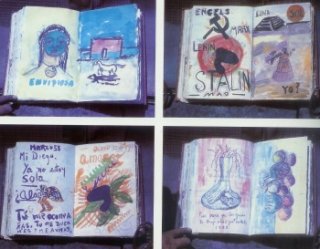
pic courtesy of www.art-perfect.de
plus: i found one of my favourite frida drawings on the net (courtesy of www.latinamericanstudies.org). hooray! she portraied herself wearing the little "hand" earring which was a big inspiration for me. the way she's wearing a single, iconic piece here... i copied that style
here it is. she did the drawing in 1946: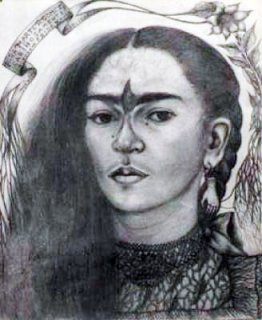

^the herrera bio is fab. just finished reading.
 frida so much. her tehuana dresses and amazing jewellery come back to my mind ever and ever again. here is a pic showing her original diary:
frida so much. her tehuana dresses and amazing jewellery come back to my mind ever and ever again. here is a pic showing her original diary: 
pic courtesy of www.art-perfect.de
plus: i found one of my favourite frida drawings on the net (courtesy of www.latinamericanstudies.org). hooray! she portraied herself wearing the little "hand" earring which was a big inspiration for me. the way she's wearing a single, iconic piece here... i copied that style

here it is. she did the drawing in 1946:

Last edited by a moderator:
Similar Threads
- Replies
- 72
- Views
- 11K
Users who are viewing this thread
Total: 1 (members: 0, guests: 1)








